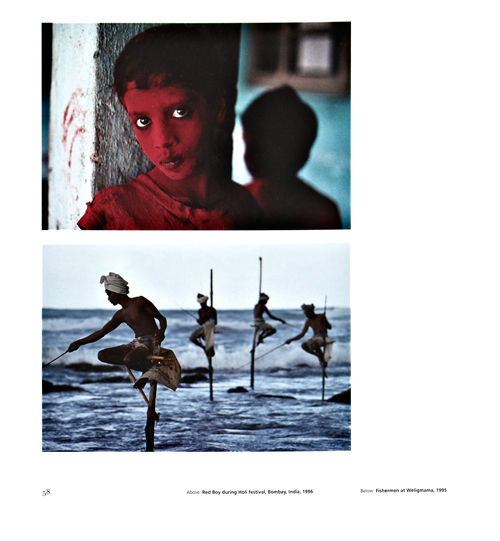| SIMON DENISON IMAGE & TEXT |
| PREVIOUS | NEXT |
STEVE McCURRY: RETROSPECTIVE Birmingham Museum & Art Gallery
National Geographic photographer Steve McCurry’s popular show, attracting over 400 visitors a day to Birmingham’s Museum & Art Gallery and twice that at weekends, presents consummate examples of travel photography largely from India, Pakistan, Afghanistan and South-East Asia. Beyond magazines his work has illustrated books and CD covers, and is sold as posters, fine-art prints and in limited edition portfolios. There is no doubting McCurry’s professional success or his ability to make striking images that fulfil all the conventional expectations of the genre: sumptuous lighting, eye-catching placement of human figures as focal points in the landscape and graphic formal arrangements of saturated colour. Yet divorced from the magazine context, and seen en masse, the photographs invite a critical reading and provoke unease that borders almost on distaste: the stomach can only tolerate so much sugar. The gallery wall text is taken from McCurry’s website, where it slips inadvertently between third-person and first-person narrative suggesting it was written by the photographer himself. ‘Steve McCurry, recognised universally as one of todays [sic] finest image-makers, … in the finest documentary tradition, captures the essence of human struggle and joy.’ This surfeit of self-regard and lack of critical self-awareness is reflected in Anthony Bannon’s introduction to Phaidon’s 2005 monograph on McCurry. Bannon, who as Director of George Eastman House ought to know better, wrote: ‘McCurry’s photographs first of all state their allegiance to the great documentary tradition of truth-telling.’ Rather, they could be used as a straightforward case-study in the partiality of documentary truth. Here all is sacrificed to the tourist’s eye view. McCurry seeks out the ‘exotic’, the traditional and the colourful: a procession of Burmese nuns with pink robes and parasols in front of a red and blue house; a trio of turbaned Sri Lankan sea-fishermen perched on poles at the shoreline; a Chinese monk in orange trousers hanging upside-down from a tree. In McCurry’s world, nothing is ‘spoiled’ by being modernised or westernised. Catastrophes are represented as arrangements of shape and colour. In a flood in Bojonegoro, Java, a pretty girl in a pink top gazes calmly at the camera, waist-deep in green duckweed in front of her blue house. Lovely. McCurry’s 1992 image of the bombed-out Afghan town of Herat is telling. Shot at sunset, the old town ruins are suffused in a pink-orange glow. In the foreground people cook a meal together around a fire in the shattered remains of one of the houses. Afghanistan, at this time, was a place of suffering and danger. But, as Bannon wrote, ‘the dangers are not present in the frame; instead one finds a declaration of eternal values’. McCurry has stated: ‘I want to be part of a tradition of photography that depicts the world as it is, that portrays humanity as it is …’ but – whatever ‘as it is’ could possibly mean – his work revives the naïve, comforting idealism of The Family of Man. McCurry’s head-and-shoulder portraits follow a similar pattern. Each depicts someone (often a child) of strikingly handsome appearance, dressed in exotic costume, separated from their surroundings against a plain background, and gazing with calm dignity at the camera. No names or histories are recorded. The decontextualised exoticism of subject matter undermines their documentary value but unquestionably contributes to their continued shelf-life as free-floating images, icons of the delightful strangeness of the undeveloped world and the ‘dignity and nobility of the human spirit’ (or some similar ideal). The facial expressions make no demands or threats; McCurry’s subjects humbly allow themselves to be possessed as images. Once again, one has to acknowledge his preeminent skill in finding so many gorgeous birds of paradise, persuading them to submit to the camera, and photographing them without any signs of self-consciousness to produce such a consistent series, even if ultimately they signify little of substance. One portrait stands out from the rest because, uniquely, there is a troubling intensity in the gaze. The green-eyed Afghan girl, photographed in a refugee camp in Peshawar in 1984, has become McCurry’s best-known image. He picked her, he says, ‘because she had these amazing eyes’. Placed on the front cover of National Geographic, she became, according to Bannon, ‘a symbol in the late 20th century of strength in the face of hardship’. She thus parallels Dorothea Lange’s anonymous Migrant Mother, an equivalent symbol for the 1930s, whom Lange photographed equally quickly, without asking her name or anything about her story. In 1978 Florence Thompson was tracked down to her trailer home, living in ordinary impoverished old age in Modesto, California. She claimed never to have made a penny out of Lange’s world-famous image and that it had done her no good. Continuing the parallel, McCurry decided to track down the green-eyed girl some twenty years on, and a documentary on his quest is shown looping in the gallery space. It makes uncomfortable viewing. The excitement of the photographer and programme makers at what they call one of the greatest ‘missing persons cases of our time’ is palpable but one has to ask: cui bono? The high-tech resources of the US National Centre for Missing and Abused Children are brought to bear on finding a woman who presumably does not regard herself as missing. Eventually Sharbat Gula is located in a remote village, looking thoroughly bewildered at all the celebratory hoo-ha but once again submitting to being photographed, without her customary burqa, for Western consumption. McCurry regards her ‘rediscovery’ as a high point in his career. |
 |
|---|---|